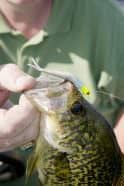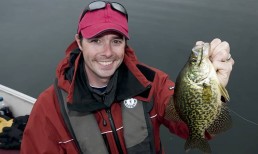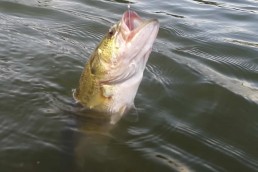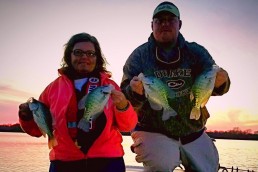For Trophy Crappies, Think Aggressive, Think…Bass?
SHARE THIS POST
Although classified as panfish, big crappies often act more like downsized versions of their aggressive cousins, the largemouth and smallmouth bass. For more consistent action it’s best to ignore the shy, bug-eating panfish stereotypes and borrow some bass tactics. This includes power-fishing with bulky baits in prime areas. Do this and you’ll hook plenty of slabs.
Find travel corridors
Crappies have a reputation of being elusive due to their tendency to suspend and their low-light feeding habits. Yet, they don’t evaporate out of lakes and rivers; they’re around and catchable for those willing to search.
To track down crappies, we can borrow a page from bass-fishing tactics, specifically running-and-gunning prime structures for active fish. The foundation for this approach is locating the travel corridors crappies use to move between feeding and lounging areas.

Sometimes crappies will hang out on the travel route. This is common on a long, weedy point extending off of a mid-depth flat. Other times they’ll be where the path intersects the feeding zone, like when a deep channel cuts into a weedy bay.
The entrance points of a cove—a channel running into a back bay or a weedy bar intersecting a timber-strewn shoreline—are good spring and summer crappie locations. These provide shelter and an abundance of minnows, invertebrates and other food. Crappies will tuck under arrowheads, lurk among wild rice or reeds and seek shade beneath timber in shallow areas.
Crappie poles
Like largemouth tactics, a vertical presentation is recommended for extracting heavy cover. The “flipping-stick” equivalent for paper-mouths is a 10-, 12-, 14- or 16-foot fiberglass telescopic pole, like the Shakespeare Wonderpole, the B‘n’M Original BreamBuster Pole and the Mr. Crappie Bream Shaker Telescopic Fishing Pole. These poles are “no-frills.” They cost $20 and reels are unnecessary, but don’t be fooled by their simplicity. In the hands of a skilled angler, a pole allows for straight-down tactics that will load the boat with cover-living crappies.
Like flipping for bass, a telescopic pole provides unmatched precision and control for dunking a jig around cover. The rod’s length, combined with keeping its tip high, prevents line from tangling in the cover while its reach and forgiving fiberglass blank make playing fish easy. These rods significantly outperform a traditional panfish, 6-foot, ultralight, spinning combo in gnarly cover.
Rigging a pole is straightforward: A section of line approximately the same length as the pole is tied to the eye of the rod tip. I use a 20-pound-test superline with a 2- to 3-foot section of fluorocarbon leader between 6- and 14-pound-test. The heavier-pound test is preferred when plunking zebra-mussel-covered brush and branches.
Any standard 1/16- to 1/8-ounce, 1 1/2- to 3-inch jig will work. When dunking tight and in heavy cover I avoid tubes, as their spiraling action encourages snags. Bucktails, Mylar and other tied jigs are better, as they drop straight and withstand lots of abuse, equating to more time fishing and less time spent getting unsnagged or fixing soft bait.
Tactics mirror those for flipping largemouths from cover: The jig is pitched into a weed pocket or an opening in timber and allowed to sink. Hits frequently come on the drop or when the jig’s at rest. Quivering the rod will also trigger a bite. Using a thru-body float is also handy to position a jig at a specific depth.
Mid-depth flats
Deep weed flats spanning 8 to 14 feet is another prime crappie hangout. Like their large-mouthed cousins, crappies concentrate on specific areas. Weedy fingers that extend into deep water off the main bed or a weed edge growing along the outside bend of a contour line are prime places; inside weedlines to shore is another prime zone.
Are you enjoying this post?
You can be among the first to get the latest info on where to go, what to use and how to use it!
Be on the lookout for changes in the bottom composition, as these attract crappies. On one lake I fish, the finest zone of a large sand-weed flat is beside an island point containing a strip of boulders. Crappies are drawn to the variation in bottom composition and the rocks extending into the basin. Sections of a flat with thick weed clumps or where the vegetation changes will also stack up crappies.
Using largemouth-inspired power-fishing tactics with a light to medium-light spinning rod teamed with 2 1/2- to 4-inch jigs is a solid strategy to sift through weed flats. Pitch the bait into pockets, cuts, lanes and outside weed edges. Work jigs quickly and thoroughly through the water column, pausing occasionally to give fish a chance to attack. Ticking the top of weeds during a swimming retrieve works well year ‘round.
Expect to catch crappies in a range of sizes, and plenty of panfish, pike and largemouths with this approach. Sometimes landing slabs is challenging during the day—don’t give up. When smaller crappies are present, it’s a clue that the weeds are likely a dusk-feeding station for bigger fish lurking nearby over deep water. While the sun’s high in the sky, take the time to learn the flat’s composition. Use GPS waypoints or buoys to mark prime spots in preparation of the dusk bite.
Smallmouth similarities
Borrowing smallmouth tactics can also boost fishing results for crappies. When chasing bronzebacks, a fundamental question to ask is whether bass are up- or down-feeding. Down-feeding smallies will root around on the bottom looking for crayfish, gobies and other floor-living delectables. As you’d expect, bottom-contact tactics shine in these scenarios. However, the same methods will be out of the strike zone when bass are up-feeding on pelagic baitfish or surface insects.
Overall, crappies are up-feeders, and where they suspend in the water column determines the most appropriate tactics. It’s a good idea to carry a mix of lures that can be used to explore different depths within the water column. A slow-sinking minnow bait is one of my favorite crappie search lures for this reason.
Aloof around structures
The concept of certain open-water smallmouth tactics transfer well to hunting crappies that are suspending out and off of the food shelves, like weed flats and bays. In these conditions, crappies are difficult to locate, but those up to the challenge will do well to adopt an inside-out approach. Combining efforts with fishing buddies to work the water column increases the effectiveness of your search. Fan-cast jigs, small spinners and sinking and diving minnow baits to weed edges and drop-offs to locate the position of crappies.
Upsize for bigger crappies
Over the years, I’ve caught crappies incidentally while fishing for bass. The message is clear: If interested in big paper-mouths, ditch the dainty tactics and use big lures. Yes, crappies will still eat tiny zooplankton as required, but big fish have appetites for “meaty” meals.
One of my go-to slab-chasers is a perch-patterned, 2 1/2-inch minnow. Spoons, paddle tail minnows, shad-profiled crankbaits and jig-spinners are also good.
Don’t be shy about fishing baits quickly either. Flash, thump, and erratic moves and commotion will pique the interest of aggressive crappies, but add pauses to give them a chance to launch a good attack. Bulky baits and fishing fast will also help bypass smaller crappies and recruit bites from bigger ones. Of course, if upsized baits and quick tactics aren’t producing or the fish are biting short, slow down and try smaller baits.
Light touch needed
Aggressive crappies can strike with rod-jarring gusto, but they’re just as likely to vacuum in a bait with little fanfare. On slack line, these hits are almost impossible to detect, especially with floating, suspending or slow-sinking horizontal presentations. The trick to sticking more fish is learning to pause a bait without stopping to retrieve the line. Do this by slowly sweeping the rod or leisurely turning the reel handle to maintain semi-taught line, and before picking up the pace again. Mastering this skill will increase sensitivity and help you feel a faint bite.
When plying your trade to favorite a crappie lake or river, consider modified and downsized bass tactics. Find crappie travel routes, fish fast during peak feeding times, cover water and try big baits.
MWO
SHARE THIS POST
Did you enjoy this post?
You can be among the first to get the latest info on where to go, what to use and how to use it!
Tim Allard
Tim Allard is a full-time outdoor journalist and author and photographer of the multi-award-winning book, Ice Fishing––The Ultimate Guide. Follow him on Instagram @timallardtips.



